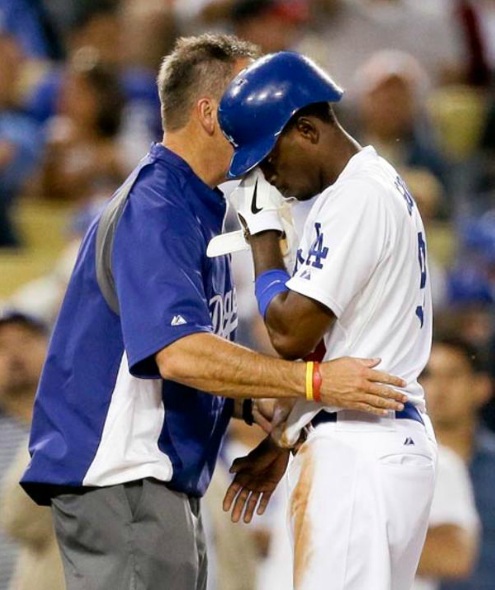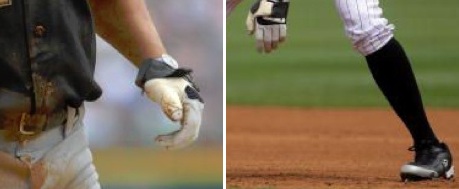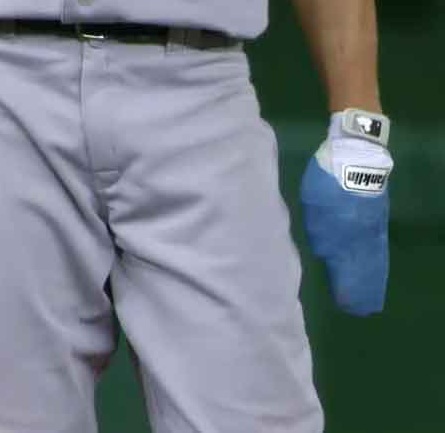The only thing worse than getting injured while playing baseball is getting injured when it was preventable; and make no mistake about it, Dee Gordon’s costly (and undoubtedly painful) thumb injury on Wednesday night could have been prevented – and it has nothing to do with the age-old debate over head-first sliding vs. feet-first sliding. How so, you ask? Allow me to elaborate.

Assistant trainer Greg Harrel attempts to comfort Dee Gordon after Gordon injured his thumb while sliding head-first into third base. (Photo credit Chris Carlson/AP)
Just prior to the trade deadline in 2010, Dodgers general manager Ned Colletti traded away highly touted catching prospect Lucas May (uggh!) and pitcher Elisaul Pimentel for a then 34-year-old Scott Podsednik of the Kansas City Royals; a trade that many (including myself) were not all that thrilled about. At the time, Podsednik (or “The Podfather” as he was affectionately called) had already been with seven different teams so it was pretty clear that he wasn’t going to be a franchise player anywhere (or even an everyday player for that matter). He was, at best, a fourth outfielder. And while the trade seemed like a really bad one at the time (and it was), Podsednik did have one attribute which made him somewhat valuable to Dodgers – he could steal bases; not like Rickey Henderson or anybody like that, but he has averaged almost 28 stolen bases per season during his 11+ years in the Bigs, which is pretty darn good. In fact, Podsednik led the MLB in stolen bases in 2004 with 70. That being said, Podsednik saw very little playing time during his two months with the Dodgers and spent most of September on the DL with a foot injury. But even at that, he still managed to steal 5 bases during his 39 games as a Dodger.
So what the heck does any of this have to do with Dee Gordon? Plenty. In 2003 Podsednik suffered a near identical injury as Gordon’s when he was with the Milwaukee Brewers. “I had an injury to my thumb in ’03 and I started wearing a hard plastic piece to protect my thumb for sliding head-first,” said Podsednik. “I wore that and had no problems with it until ’08, when I ended up breaking my pinkie finger sliding into second base. Then I got with a hand therapist and she came up with this (current) cast to protect all my fingers, including the thumb… it has worked perfectly and I haven’t had any problems since,” he added.

The first protective sliding cast that Podsednik wore after his 2003 injury protected only his thumb. (Photo credit Uni-Watch.com)
In 2008 while still with the Royals, Podsednik was interviewed by a blogger named Paul Lukas from Uni-Watch.com. During that interview, Lukas asked Podsednik if he knew of anyone else in the MLB wearing the protective cast (which Lukas cleverly dubbed the PodCast). Podsednik’s answer to this question came as quite a surprise to me: “A lot of guys wear sliding guards to protect their wrists. I’d say about 80% of the base stealers wear something like that. But I haven’t noticed any other teams wearing the cast.”

Podsednik began wearing the current version of his fiberglass sliding cast during the 2008 season. (Photo credit NikeTalk.com)
When Podsednik was traded to the Dodgers, I immediately noticed that he would always put on an unusual looking glove whenever he got on base. My initial thought was that it was some type of new base stealing glove to prevent him from scraping his hand, but leave it to the great Vin Scully to set the record straight by explaining that it was actually a custom made fiberglass cast designed to protect Podsednik’s fingers while head-first sliding. “What a great idea,” I remember thinking to myself at the time fully expecting to see more guys wearing them, yet here we are almost two years later and I have yet to see anyone else wearing one. You would think that anybody whose greatest asset is speed and base stealing would definitely wear one of these things – someone like… say… maybe… Dee Gordon.
Wait a minute… What’s wrong with this picture? Perhaps Podsednik should have another Podcast made for his right hand – although I suspect the reason that he only wears one is so that he can actually grab the bag with the other hand when necessary to stay on the bag. (Photo credit Dustin Bradford / Icon SMI)
Regardless, it’s a pretty safe assumption that if Dee Gordon had been wearing one of these things his injury would not have happened and this post would not have been written.




 July 5th, 2012 at 9:46 am
July 5th, 2012 at 9:46 am  by Ron Cervenka
by Ron Cervenka  Posted in
Posted in 

I expect if runners used that protection for their fingers, they could virtually eliminate finger injuries on slides, and eliminate the safety issue in sliding.
The “Podcast” is fine to protect the hand, but I’ll say it again (and I know we disagree here). Head first slides leave a player vulnerable to not only hand and finger injuries but also the face, head, arms, wrist, and shoulders. Feet first slides when executed properly are much safer in my opinion. And when I say “executed properly” I refer to player like Pedro Guerrero who never learned how to slide feet first, and Tommy Davis and Bill Buckner, who botched their slides…resulting in broken ankles. Let the debate continue…
I’m certainly in agreement with that Evan, That is, the added risk in head first slides. Above I meant to say, “… eliminate that safety issue in sliding.”
As Evan noted over on the forum, I disagree with him (and apparently Bluenose Dodger as well) that head-first sliding is more prone to injury than foot-first sliding EXCEPT FOR THE HANDS (hence the above post) and believe that if done properly, a head-first slide significantly increases the rate of success (why else would they be doing it?).
The obvious exceptions are on force plays and plays at 1B where no tag is necessary. I have long felt that sliding into 1B (head-first or otherwise) is dumb. It is a proven fact that it is faster to run straight ahead and through the play which, of course, can only be done at 1B and at home. The BIG difference between 1B and home is that a catcher is permitted to block the plate at home, but this is not permitted at any other base. In my opinion, sliding into 1B (head-first or otherwise) should only be done to avoid a tag by the first baseman when he is off of the bag.
One thing that I think gets overlooked is that the bases used in today’s game are not the proverbial “bags” that were once used. I suspect that the change over to an anchored hunk of very solid and heavy plastic may be responsible for a few more injuries (head-first or feet-first) than the old bags were (no offense intended to anyone).
If the head first slide significantly increases the rate of success, I wonder why all base stealers don’t slide head first. Perhaps they do. I expect it has to do with comfort level. That is, which way players slide.
The research doesn’t seem to be conclusive. I’m not sure how to post links on the blog so did so in the forum. Some studies suggest head first is faster, others don’t.